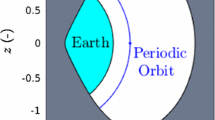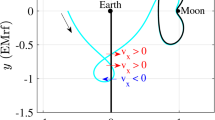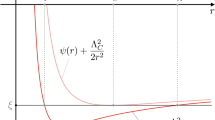Abstract
The present paper addresses the existence of J 2 invariant relative orbits with arbitrary relative magnitude over the infinite time using the Routh reduction and Poincaré techniques in the J 2 Hamiltonian problem. The current research also proposes a novel numerical searching approach for J 2 invariant relative orbits from the dynamical system point of view. A new type of Poincaré mapping is defined from different central manifolds of the pseudo-circular orbits (parameterized by the Jacobi energy E, the polar component of momentum H z and the measure of distance Δr between the fixed point and its central manifolds) to the nodal periods T d and the drifts of longitude of the ascending node during one period (ΔΩ), which differs from Koon et al.’s (AIAA 2001) definition on central manifolds parameterized by the same fixed point. The Poincaré mapping is surjective because it compresses the three-dimensional variables into two-dimensional images, and the mapping degenerates into a bijective mapping in consideration of the fixed points. An iteration algorithm to the degenerated bijective mapping is proposed from the continuation procedure to perform the ergodic representation of E- and H z -contour maps on the space of T d –ΔΩ. For the surjective mapping with Δr ≠ 0, different pseudo-circular or elliptical orbits may share the same images. Hence, the inverse surjective mapping may achieve non-unique variables from a single image, which makes the generation of J 2 invariant relative orbits possible. The pseudo-circular or elliptical orbits generated from the surjective mapping will be defined in different meridian planes. Hence, the critical contribution of the present paper is the assignment of J 2 invariant relative orbits to different invariant parameters E and H z depending on the E- and H z -contour map, which will hold J 2 invariant relative orbits for extended durations. To investigate the high-order nonlinearity neglected by previous studies, a formation configuration with a large magnitude of 500 km is successfully generated from the theory developed in the present work, which is beyond the scope of the linear conditions of J 2 invariant relative orbits. Therefore, the existence of J 2 invariant relative orbit with an arbitrary relative magnitude over the infinite time is achieved from the dynamical system point of view.
Similar content being viewed by others
References
Alfriend, K.T., Yan, H.: An orbital elements approach to the nonlinear formation flying problem. In: International Formation Flying Symposium, Toulouse, France, Oct 29–31 (2002)
Breger, L., How, P.: Partial J 2-invariance for spacecraft formations. In: AIAA/AAS Astrodynamics Conference, Keystone, AIAA pp. 2006–6585 (2006)
Broucke R.A.: Numerical integration of periodic orbits in the main problem of artificial satellite theory. Celest. Mech. Dyn. Astron. 58, 99–123 (1994)
Brouwer D.: Solution of the problem of artificial satellite theory without drag. Astron. J. 64(9), 378–397 (1959)
D’Amico S., Montenbruck O.: Proximity operations of formation flying spacecraft using an eccentricity/inclination vector separation. J. Guid. Control Dyn. 29(3), 554–563 (2006)
Deprit A., Rom A.: The main problem of artificial satellite theory for small and moderate eccentricities. Celest. Mech. 2, 166–206 (1970)
Duan, X., Bainum, P.M.: Design of spacecraft formation flying orbits. In: AAS, pp. 03–588 (2003)
Fasano G., D’Errico M.: Modeling orbital relative motion to enable formation design from application requirements. Celest. Mech. Dyn. Astron. 105, 113–139 (2009)
Halsall M., Palmer P.L.: Modelling natural formations of LEO satellites. Celest. Mech. Dyn. Astron. 99, 105–127 (2007)
Koon, W.S., Marsden, J.E., Murray, R.M., Masdemont, J.: J 2 Dynamics and formation flight. In: AIAA Guidance, Navigation, and Control Conference and Exhibit, Montreal, AIAA, pp. 2001–4090 (2001)
Martinusi V., Gurfil P.: Solutions and periodicity of satellite relative motion under even zonal harmonics perturbations. Celestl. Mech. Dyn. Astron. 111, 387–414 (2011)
Montenbruck O., Kirschner M., D’Amico S., Bettadpur S.: E/I-vector separation for safe switching of the GRACE formation. Aerosp. Sci. Technol. 10(7), 628–635 (2006)
Sabatini M., Izzo D., Palmerini G.: Minimum control for spacecraft formations in a J 2 perturbed environment. Celestl. Mech. Dynl. Astron. 105, 141–157 (2009)
Schaub H., Alfriend K.T.: J 2 Invariant relative orbits for spacecraft formations. Celestl. Mech. Dyn. Astron. 79, 77–95 (2001)
Sengupta P., Vadali S.R., Alfriend K.T.: Second-order state transition for relative motion near perturbed, elliptic orbits. Celestl. Mech. Dyn. Astron. 97, 101–129 (2007)
Vadali, S.R., Schaub, H., Alfriend, K.T.: Initial conditions and fuel-optimal control for formation flying satellite. In: AIAA GNC Conference, Portland, Oregon, paper no. AIAA, pp. 99–426 (1999)
Vadali S., Sengupta P., Yan H., Alfriend K.T.: Fundamental frequencies of satellite relative motion and control of formations. J. Guid. Control Dyn. 31(5), 1239–1248 (2008)
Xu M., Xu S.J.: J 2 Invariant relative orbits via differential correction algorithm. Acta Mech. Sin. 23(5), 585–595 (2007)
Xu M., Xu S.J.: Nonlinear dynamical analysis for displaced orbits above the planet. Celestl. Mech. Dyn. Astron. 102(4), 327–353 (2008)
Yan, H., Alfriend, K.: Numerical searches and optimal control of J 2 invariant orbits. In: 16th Annual AAS/AIAA Spaceflight Mechanics Meeting, Tampa, AAS, pp. 06–163 (2006)
Author information
Authors and Affiliations
Corresponding author
Rights and permissions
About this article
Cite this article
Xu, M., Wang, Y. & Xu, S. On the existence of J 2 invariant relative orbits from the dynamical system point of view. Celest Mech Dyn Astr 112, 427–444 (2012). https://doi.org/10.1007/s10569-012-9401-7
Received:
Revised:
Accepted:
Published:
Issue Date:
DOI: https://doi.org/10.1007/s10569-012-9401-7




